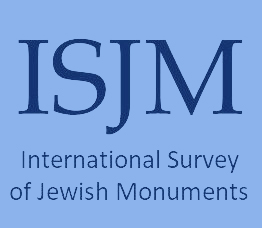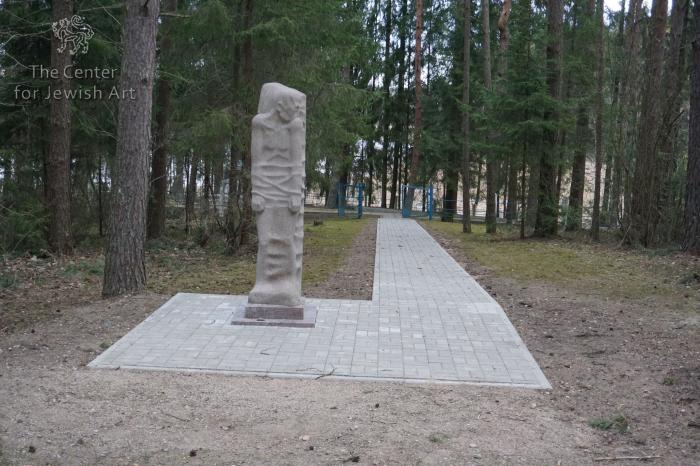Obj. ID: 52960 Sculpture “Pain” near the Holocaust memorial in Utena, Lithuania, 1988

Memorial Name
Who is Commemorated?
4,600 Jews from Utena, Alanta, Debeikiai, Inturkė, Kuktiškės, Radeikiai, Tauragnai, Užpaliai, and Vyžuona murdered at this site.
Description:
The gray granite sculpture is installed at the beginning of the path leading to the killing site and mass graves.
It represents a man with his head turned left and his arms along the body, tied by ropes to a vertical slab.
Inscription:
Information stand in Lithuanian:
Žydų žudynių vieta ir kapai
1941 m. vasarą hitlerininkai ir jų talkininkai šioje Rašės miško teritorijoje šaudė Utenos, Tauragnų, Molėtų ir kitų vietovių
gyventojus, daugiausiai žydus.
1941 m. liepos 14 d. Utenoje buvo išklijuoti skelbimai su įsakymu visiems Utenos žydams per 12 val. palikti miestą. Už įsakymo
nevykdymą buvo grasinta sušaudymu. Apie 2 tūkst. žydų tautybės asmenų pateko į Šilinės miške įrengtą stovyklą, iš kurios grupėmis
buvo vedami į sušaudymo vietą Rašės miške. Pirmasis masinis Utenos žydų šaudymas buvo įvykdytas 1941 m. liepos 31 d.
Nužudytas 251 žydų tautybės asmuo – 235 vyrai ir 16 moterų. 1941 m. rugpjūčio 7 d. buvo įvykdytas antrasis masinių žudynių
etapas. Sušaudyta 570 žydų tautybės asmenų – 483 vyrai ir 87 moterys. Utenos getas likviduotas ir likusieji gyvi Utenos žydai buvo
nužudyti 1941 m. rugpjūčio 29 d. Sušaudyti 3782 Utenos ir Molėtų žydų tautybės asmenys (Karl Jäger pateiktas vienas
skaičius dviem vietovėms). Sudėtinga nustatyti tikslų nužudytų asmenų skaičių, todėl dažniausiai remiamasi Karl Jäger ataskaita.
Pasibaigus Antrajam pasaulinam karui, Holokaustą išgyvenusių žydų iniciatyva ir lėšomis žudynių vietoje pastatytas
memorialinis obeliskas.
Įprasminant Holokausto aukų atminimą, 1988 m. čia pastatyta Utenos krašto skulptoriaus Valentino Šimonėlio sukurta skulptūra
„Skausmas“.
Ši Holokausto atminties vieta įtraukta į Kultūros vertybių registrą
Translation: In the summer of 1941, the Nazis and their collaborators shot and killed residents, mostly Jews, from Utena, Tauragnai, Molėtai and other locations, in this part of the Rašė forest. On 14 July 1941, notices were posted in Utena, ordering all the Jews of Utena to leave the city within 12 hours. It was threatened to shoot those who failed to obey. About two thousand Jews were confined in a camp set up in the Šilinė forest, from which groups were led away to the killing site in Rašė forest. The first mass shooting of Utena's Jews was carried out on 31 July 1941. 251 Jewish people were killed: 235 men and 16 women. On 7 August 1941, the second stage of the mass killings was carried out. 570 Jewish people were shot: 483 men and 87 women. The Utena ghetto was "liquidated" and Utena's remaining Jews were killed on 29 August 1941. 3,782 Jewish people from Utena and Molėtai were shot (Karl Jäger's number was provided for both locations in total). It is difficult to determine the precise number of those killed, so Karl Jäger's report is usually cited.
After the end of the Second World War, a memorial obelisk was built at the site of the killings at the initiative and with the funds of those of Utena's Jews who survived the Holocaust. In memory of the victims of the Holocaust, the sculpture Skausmas (Pain), created by local sculptor Valentinas Šimonėlis, was placed at the site in 1988. This site, forever reminding us of the Holocaust, is listed on the Registry of Cultural Heritage Properties. (translation from the website https://www.utenainfo.lt/, see here).
Commissioned by
Probably, Utena local authorities
The first mass shooting of Jews in Utena was carried out on July 31, 1941. SS-Obersturmführer Joachim Hamann’s Rollkommando, who had arrived from Kaunas, together with local white armbanders shot 235 Jewish men and 16 Jewish women.
On August 7, 1941, the second mass execution of Jews took place. On that day in the forest of Rašė the Rollkommando together with local white armbanders shot 483 Jewish men and 87 Jewish women.
The Utena ghetto was liquidated and the remaining Utena Jews were killed on August 29, 1941. This time not only men and women were shot but also children, infants, and elderly people. The Rollkommando together with the white armbanders of Utena shot 3,782 Jews from Utena and Molėtai (Jäger gave only one figure in his report for those two places).
The Soviet commission investigating Nazi crimes in the forest of Rašė found 3 big trenches and a few smaller pits in 1944. The commission estimated that about 9,000 people had been killed there. It is more likely that the Nazis and local collaborators killed about 4,600 Jews from Utena and surrounding areas. In 1962 the remains of the Jews murdered in Užpaliai and Vyžuonos were moved here
The monument was installed probably in 1945-47, by the survivors. (see here). In 1988, it was supplemented by the sculpture “Pain” by the local sculptor Valentinas Šimonėlis.
Information stand with the text in Lithuanian was erected in 2022 or 2023.
On March 1, 1993, the monument was registered in the State Cultural Register of the Republic of Lithuania as a site of national importance (no. 11313).
Jakulytė-Vasil, Milda. Lithuanian Holocaust Atlas (Vilnius: VIlna Gaon State Jewish Museum, 2011), pp. 254-255.
Kultūros vertybių registras, https://kvr.kpd.lt/#/heritage-detail/f80c8245-bf66-4f6b-a926-f1feac802557., https://kvr.kpd.lt/#/ (accessed April 24, 2022)
Levinson, Yosif, Skausmo knyga. The Book of Sorrow. Dos bukh fun veytik. Sefer ha-keev (Vilnius: VAGA Publishers, 1997)., pp. 179-181.
"Site of the mass killing of Jews, and their graves," Website of the Utenos Turismo Informacijos Centras, https://www.utenainfo.lt/en/sightseeing-places/jewish-genocide-graves-in-skaistasilis-forest/ (accessed January 3, 2024)











